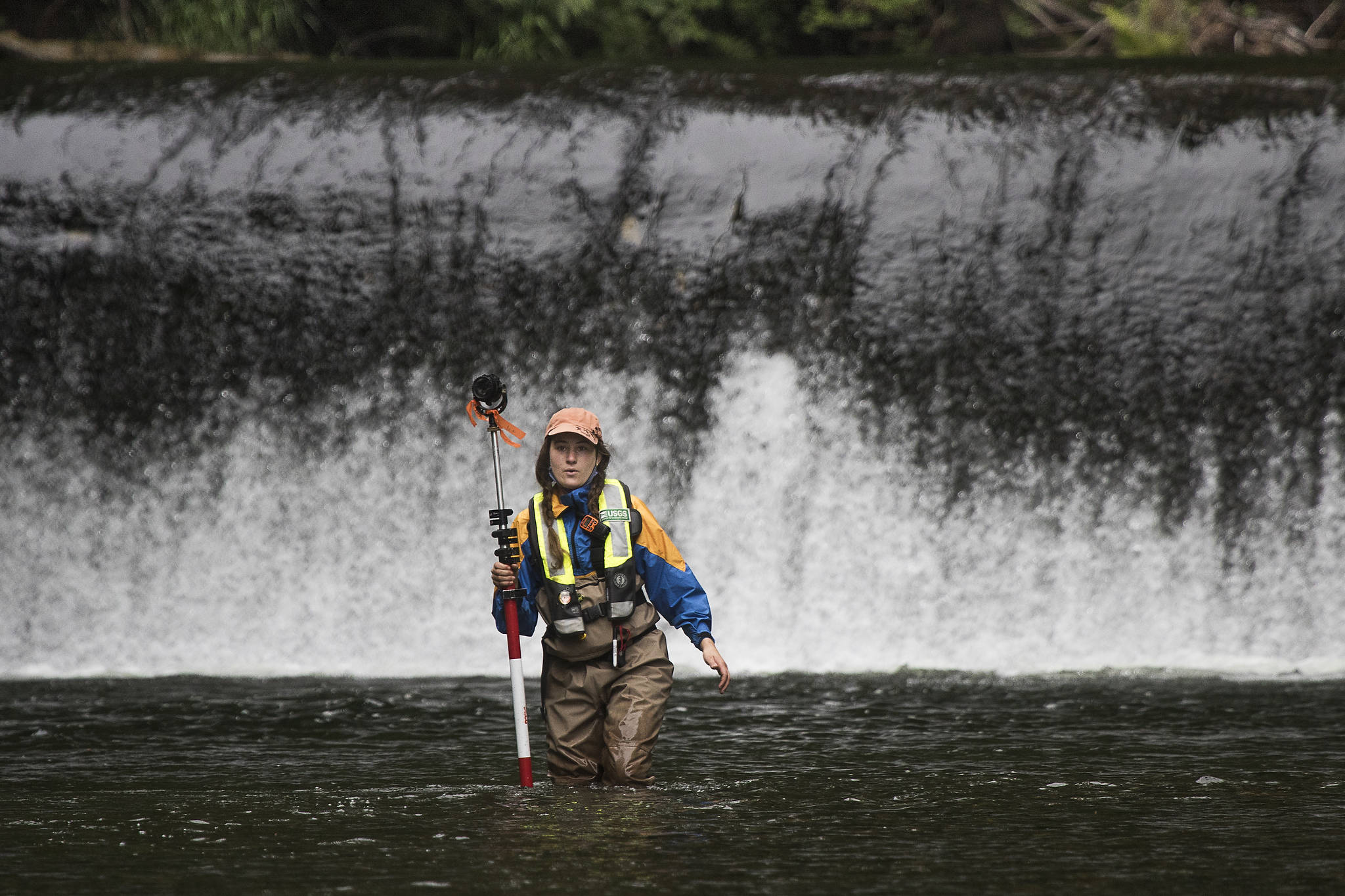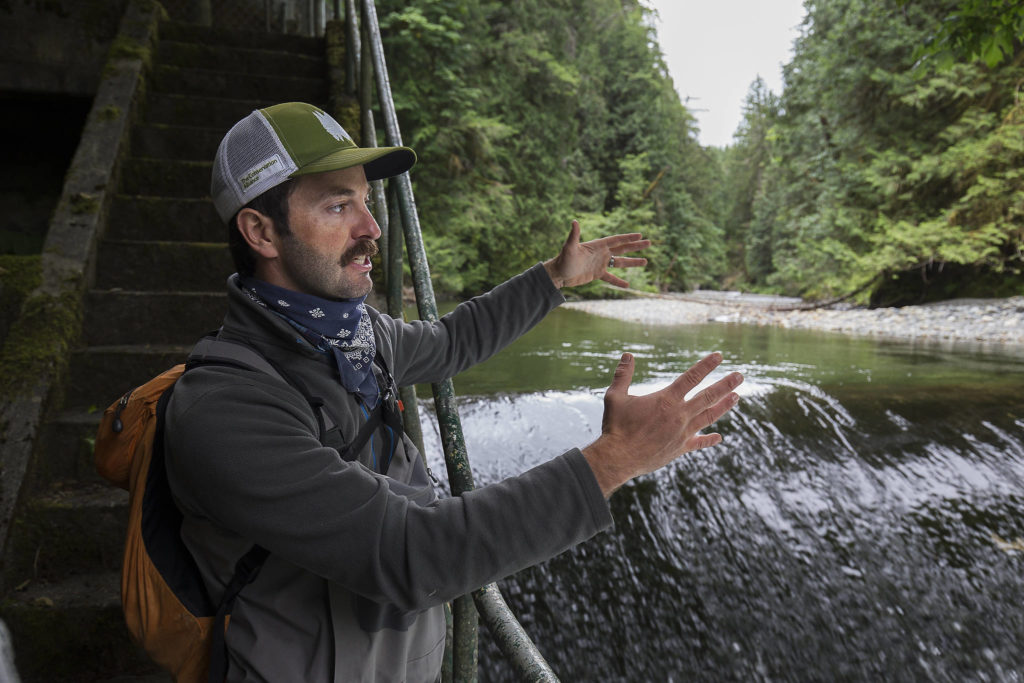GRANITE FALLS — The blue-green waters of the upper Pilchuck River are ideal habitat for some of Puget Sound’s most endangered salmon.
Large conifer trees line the banks, keeping the water shady and cool, while fallen trunks provide “hidey spots” for juvenile salmon to grow. The land upstream is mostly working forest, protecting the river from residential contamination.
But much of this pristine habitat, a third of the entire Pilchuck River, is blocked by a 10 foot high by 60 foot wide hunk of concrete.
A few miles south of Granite Falls, the Pilchuck Dam once diverted drinking water for part of Snohomish. About two years ago, the city stopped using that water source, leaving the dam with no practical purpose.
“It’s pretty much useless now,” said Brett Shattuck, a restoration ecologist with the Tulalip Tribes.
Preparations to remove the major barrier to fish begin next week.
On Tuesday, Tulalip Tribes and United States Geological Survey crews surveyed the river, mapping its floor in order to track how sediment moves after the dam is gone.
The dam never had a reservoir, so it didn’t provide water storage or flood protection.
“Once we remove the dam, it won’t be any different in terms of water coming down,” Shattuck said.
There’s also no expected increase in flooding risk.
In past years, Coho salmon, Chinook and Steelhead all swam upriver and attempted to navigate the structure.
“They just try to jump over the dam and quite tragically smash their faces,” Shattuck said.
The dam was first installed in 1912. A new one with a fish ladder was built in the 1930s, but it never really worked well.
“Normally (the fish) just try to jump over the dam instead of knowing that if they just go to the right there’s a fish ladder,” Shattuck said. “They just see turbulent water.”
The site is on Snohomish city property, and there’s no public access. There are no plans to change that, Shattuck said. But there are some Department of Natural Resource trails nearby that follow the river.
Next week, crews plan to build access routes to the water. By mid-July, excavators will start removing the dam one concrete chunk at a time.
To do that, construction workers will route the river’s flow to one side while they demolish a portion of the dam. Then they’ll switch sides.
Live camera feeds will document the river’s return to its natural state.
The entire project, a partnership between the Tulalip Tribes and the city of Snohomish, will cost about $2 million made up of tribal, local, state, federal and private funding.
The Pilchuck Dam removal is a unique project because nothing needs to be built in its place, Shattuck said. Normally, the removal of one culvert or dam means replacing it with another, more fish-friendly one.
But in this case, the Pilchuck River will be released to run its natural course.
“You’re just going to see a natural river in place of a dam,” Shattuck said.
In September, Chinook salmon will be the first species to reach the reopened waters.
In the past, they’ve run into the dam before fall rains raise the river’s flow. Few, if any, get over the structure, Shattuck said.
Puget Sound Chinook salmon, a key food source for endangered Orcas, are listed as threatened under the federal Endangered Species Act.
Chinook salmon populations have been depressed for many decades, in part due to blockages like the Pilchuck Dam, said Tulalip Tribes Environmental Specialist Colin Wahl.
Last year, the estimated number of Chinook returning to rivers in the Snohomish Basin was the lowest on record, which dates back to 1965. Roughly 1,644 fish made the journey upstream.
In 2019, data from the Department of Fish and Wildlife and the Tulalip Tribes estimated about 50 Chinook returned to the Pilchuck to spawn. The highest estimate on record was in 2008, with 515 spawners.
Historic modeling suggests the Pilchuck could support nearly 12,000 fish spawning each year, Wahl said. The spawning estimates from 2019 are about .4% of that capacity.
Once the dam is removed in August, the fish will have unrestricted access to 37 miles of habitat.
“We’re really hoping that by increasing the Chinook population we can also help Orcas by providing a food source,” Shattuck said.
But the Pilchuck Dam was just one small barrier to fish recovery.
“The removal of the dam is not solely going to save the fish population in the Pilchuck or in Puget Sound,” Shattuck said. “This is part of the puzzle, but definitely not the last piece.”
Julia-Grace Sanders: 425-339-3439; jgsanders@heraldnet.com.
Talk to us
> Give us your news tips.
> Send us a letter to the editor.
> More Herald contact information.




























